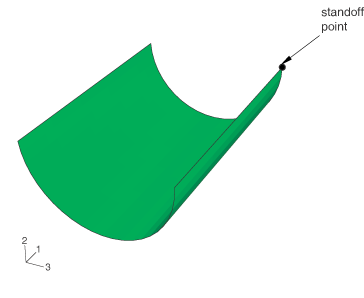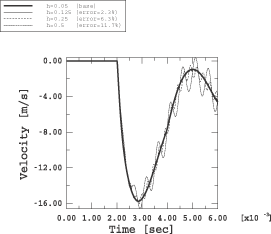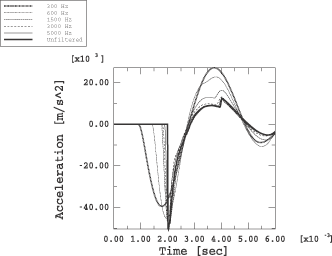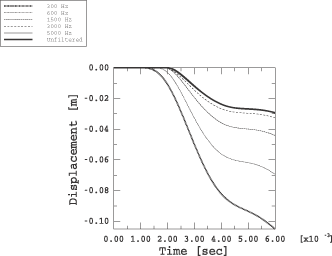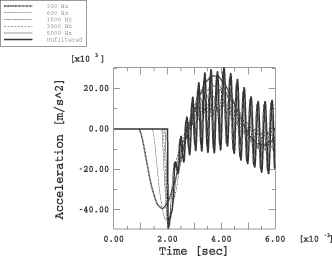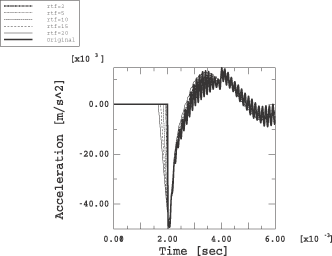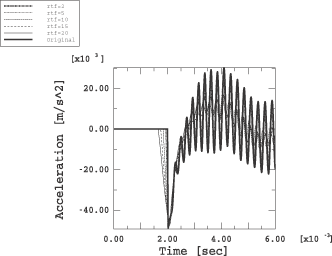First, convergence of the structural response at the standoff point is
examined, applying the original KF loading
signal. Errors are reported in a -norm
over the entire 6 ms duration of the response. The converged solution is formed
by successively applying finer meshes until a desired relative accuracy is
obtained. From
Figure 2
and
Table 1
we conclude that a mesh with h=0.025 m is a reference
solution. The solution with h=0.05 m can also be
considered converged; therefore, it can become the reference solution for
subsequent studies (the acceleration response differs by only 1.1% with respect
to the solution with h=0.025 m).
Figure 3
and
Figure 4
depict the relative accuracy of the displacement and velocity responses with
respect to the solution with h=0.05 m. For example,
Figure 3
shows that if an accurate velocity response is of interest, element size
restrictions can be relaxed to h=0.25 m (6.3% relative
error versus the reference configuration); if the displacement response is of
interest, the element size restrictions can be relaxed further to
m (Figure 4).
Figure 5
is constructed by defining a mesh characteristic frequency,
,
used as x-data for the error curve. For a given number of
elements, N, per excitation wavelength, the mesh
characteristic frequency is
where
is the characteristic wave speed (here the shell flexural wave speed) and
h is the element diameter. The structural wave speed is
dispersive; i.e., it varies with the excitation frequency. In
Figure 5,
however, a constant reference value of =1200
m/s is used. The previously defined mesh characteristic frequency also depends
on the user's choice of the number of elements per wavelength,
N. To preserve accuracy and to address the pollution
effect (Ihlenburg and Babuska, 1995), N should increase
with the excitation frequency. The choice of h,
N, and the wavespeed in the medium,
,
determines the value of the mesh characteristic frequency,
,
which can be interpreted as a cutoff frequency for designing the filtered
signal.
Figure 5
shows that by considering a mesh with h=0.05 m and
N=15, the mesh characteristic frequency becomes
=1600
Hz. If the number of elements per wavelength is relaxed to
N=5,
will increase to 4800 Hz. If the latter value is applied as the cutoff
frequency, the filtered signal will capture the true signal more accurately;
however, it is likely to produce more noise if the waves are not resolved
properly.
The study presented above may lead to meshes that are impractical for
realistic models, especially if the acceleration response is of primary
interest. For this model of 10 m length, an element of 0.05 m provides
sufficient accuracy at the standoff point. Since this may lead to prohibitive
computational costs for realistic models, the next studies address ways to
relax the element size restraints by modifying the shock signal applied to the
structure. These following studies examine the impact of filtering and modified
rise time upon the element size restrictions, in an attempt to minimize the
noise at coarse meshes.
Filtered signals are applied successively to the structure, in an attempt to
quantify the dependence of the optimal cutoff frequency on the element size.
The sine-Butterworth second-order filter is used. Although filter performance
is very important for optimal results, a comparison of various filtering
techniques is beyond the purpose of this study.
The filtered signals are postprocessed via linear scaling with the parameter
a such that the final and original signals are equivalent
in a n-norm:
The norm can be varied to design a final signal suitable for various
responses: since initially the KF is applied
as a load signal, the infinity norm is suitable for obtaining a more accurate
acceleration response, while the 1-norm (impulse conservation) is suitable for
obtaining a more accurate velocity response.
For this study filtered signals are designed with scaling parameters
suitable for acceleration response. Sample postprocessed filtered signals are
presented in
Figure 6.
By applying these as incident wave loads on the mesh with
h=0.05 m, the results shown in
Figure 7,
Figure 8,
and
Figure 9
are obtained for the acceleration, velocity, and displacement, respectively.
There is a clear distinction between
Figure 7—a
well-captured acceleration response—and
Figure 8
and
Figure 9—which
are poor estimates of the velocity and displacement responses—since the applied
filtered load has a significantly higher impulse than the unfiltered signal.
The results presented in
Figure 10
and
Figure 11
are obtained by applying the same load signals to coarser meshes. A summary is
presented in
Table 1
and
Figure 14.
The expected trend is visible: as the mesh coarsens, the acceleration response
when applying filtered signals is considerably less noisy than the response for
unfiltered signals. As the mesh is refined, the response converges to the
“wrong” solution given by the filter of choice. Thus, when computational
resources are scarce, there is an obvious benefit to applying prefiltered
signals, which attenuate the noise due to insufficient spatial discretization.
As an alternative to the sine-Butterworth filter, the signal can be
idealized in a heuristic manner by using a linear rise, followed by an
exponential decay. By keeping the decay constant, you can study the sensitivity
of the structural element size to the rise time of the shock signal.
The original rise time, ,
of the KF signal is multiplied by a rise time
factor (=
2, 5, 10, 15, 20) to obtain new signals, which are then applied to the
structure. To account for noise contributions only, the error of the
acceleration response is reported on the decay portion
[],
where
is the time stamp of the peak amplitude of the load signal.
The results using this technique are presented in
Figure 12
and
Figure 13
and summarized in
Table 2
and
Figure 15.
By comparison with
Figure 14,
the smoothing strategy appears considerably more effective for the acceleration
response than using a sine-Butterworth filter. For example, the case with
h=0.125 m and =20
(scaling the upper bound of the spectrum at ~2250 Hz) yields an error of 9%;
for the same element size with h=0.125 m, the
sine-Butterworth filter with a cutoff frequency of 3000 Hz yields a 32% error.
